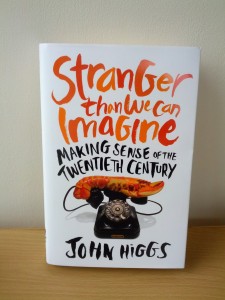This weekend saw the launch of John Higgs’ new book Stranger than we can Imagine. It was also the first chance I’d had to read the copy I bought a few weeks ago at the Wilderness Festival, where I spoke just after John. His book on the KLF is one of my favourite books, so I’d been looking forward to this for some time. It’s a pretty bold undertaking, being a history of the twentieth century and takes its title from a quote by the physicist Sir Arthur Eddington.
Apparently a review in a history journal said that, rather than being the Great Man theory of history, this is the strange person history. The figures Higgs picks are marginal: Jack Parsons, Aleister Crowley, Emperor Norton, Mark Everett. There is a fantastic portray of Von Neumann as a supervillain, which vividly illustrates the madness of cold war strategy. The book’s theme is the shifting frames of reference at the start of the century in areas such as psychology, politics, science and literature. My favourite quote is the cautious claim that “If you were feeling brave you could argue that Einstein was a modernist scientist, although to do so would annoy a lot of physicists”
I tend to be a little nervous about popular accounts of physics. Over the years I’ve read too many accounts of quantum entanglement that veered off into telepathy. The handling of science here is careful and thoughtful without being dry, particularly the discussions of special relativity.
(The time traveller and poet Rosy Carrick recently teased me for the class of degree I earned and, yes, I was much less successful than she was as an undergraduate. However, I feel that I achieved the aims JA Smith set out in his teaching: “Nothing that you will learn in the course of your studies will be of the slightest possible use to you in after life – save only this – if you work hard and diligently you should be able to detect when a man is talking rot, and that, in my view, is the main, if not the sole, purpose of education.”)
Another interesting discussion is about the alleged riots at the opening night of Stavinsky’s rite of Spring. Like the riots that were said to have happened in response to Tzara’s random poetry, there is little evidence that this happened. Higgs dismantles the myth, then turns to a surprising conclusion: “An actual riot only tells us about the impact of the performance on one particular day. A mythic riot, on the other hand, shows us that the impact of the music transcends that point in time. Myths don’t just crop up anywhere.”
The narrative of the book emerges quite late, and for a while I wasn’t sure if there was a story to be told, but the conclusion is fascinating. Something happened in the 20th century and this book provides an interesting explanation of what this was.
PS – Higgs raises an interesting question about UFOs through his outline of a discussion by Jung. UFOs, according to Jung, are a modern manifestation of things seen through the ages, such as fairies and angels. Since the cameraphone became ubiquitous, UFO sightings have dropped off – what is going to replace them?
